Google Flights Offers a Slick Travel Planning Interface
For some years now, whenever I’ve been planning air travel, I’d start with the Kayak app on the iPhone. (It’s fine on the iPad too, but just as the best camera is the one you have with you, the iPhone is the best travel planner for me, because it’s always in my pocket.) With Kayak, you can quickly specify where you’re flying from and to (with an option to check nearby airports), your travel dates, and how many people are in your party. Kayak then shows both outbound and return flights as groups, sorted by price, and lets you filter the results to eliminate trips with too many stops, or with awkward departure or arrival times.
But setting up all these options, and fiddling with your dates, if you’re flexible and looking for inexpensive flights, gets fussy fast.
So when I ran across a mention of Google Flights, a service that’s been around since 2011 but that I hadn’t heard of before, I gave it a try. Frankly, it’s an impressive demonstration both of what companies can do when they truly understand big data, as Google obviously does, and when designers put a great deal of thought into a Web-based interface that works for the user proactively.
The base interface is familiar: you choose a round trip, one-way trip, or multi-city trip; set the class of ticket you want; and say how many tickets you need. Then it’s a matter of entering the cities you’re flying from and to, along with your preferred dates. Filter menus below the date picker let you restrict the results by number of stops, price, airline, departure and arrival time ranges, overall duration, and connecting airports.
But the niceties become evident quickly. For instance, I live in Ithaca, New York, and three nearby airports often have lower prices than the Ithaca Tompkins Regional Airport. Clicking the + button in the Departure Airport field reveals a helpful popup that lets me include those airports in the search, showing the best price at each for my dates, and how far away they are. You might already know all this for your home area, but Google Flights also provides the same nearby airport information and pricing for
destinations, which you’re less likely to know. There’s nothing new about travel planning services checking nearby airports, but none I’ve seen does as good a job of highlighting lower prices.
Google Flights continues that highlighting in the Calendar view, where you pick departure and return dates. Airline pricing varies hugely depending on how long you stay and on which days you fly, but few travel planning services do more than check for alternatives within a day or two of dates you specify, and they seldom make it easy to see how pricing changes with dates.
In its Calendar view, once you enter a departure date, Google Flights shows the best fare in small type under each possible return date, coloring the best ones in green. A single click selects your departure date, and the next click selects your return date, but to explore the options for earlier departure dates, click the left-pointing arrow in that field. As you do, the best fares change on the fly as Google calculates the cascading effect that different dates have on the length of your stay.
Calendar view works well for me, but Google Flights also displays the same information in a Flexible Dates view. It offers a grid with departure dates running horizontally and return dates going vertically and the lowest fares highlighted in green. Depending on how you parse data, it may be a faster and more understandable way to zero in on the best combination of travel dates and fares.
The third and final date-related view in Google Flights is the Price Graph view, which shows the lowest fares for trips of different lengths, starting on different days. Honestly, this strikes me as the least useful view unless you’re planning a vacation where the dates are highly flexible and you want to optimize on price. But for us Type-A personalities who have to know we’re getting the best possible deal, the Price Graph view can provide some welcome reassurance.
Once you’ve settled on your dates, it’s time to pick outbound and return flights. The first thing to notice is that if you were working quickly and didn’t optimize your dates for the lowest possible fare, Google Flights tells you that you could get a notably lower fare by leaving on a different date.
After you’ve picked a flight based on all the other standard variables, like departure time, total flying time, number of stops, and arrival time, Google Flights provides a clean display of the times and stops. Notably, it also helpfully provides more detail about the actual airplanes you’ll be flying in. As you can see in the screenshot, short flights out of Ithaca never have Wi-Fi or in-seat power, but the longer hop from Detroit to San Francisco will have both, along with on-demand video. It
even displays the average legroom.
When you’ve selected both your outbound and return flights, Google Flights gives you the options to book your tickets (which often requires sending you to the individual airline sites), save the itinerary so you can watch it for price changes, and share it. There’s nothing particularly innovative here, and it can be a shock to switch from the clean, smooth interface of Google Flights to the cluttered, awkward airline sites. I presume the airlines aren’t interested in giving Google unfettered access
to their backend systems, much as it might be a win for the customer.
One caveat. After the initial publication of this article, several TidBITS readers weighed in with complaints about how Google Flights worked with international flights. I don’t have the experience or real-world opportunity to test such itineraries, but if you’re not in the United States, or are planning travel to other countries, take the Google Flights prices with a grain of salt until you can verify them on the airlines’ sites. As with all travel-planning services, Google Flights is only as good as its
data, and nothing prevents you from trying Kayak or Expedia or Orbitz or any other competing service.
In the end, Google Flights isn’t revolutionary, but it offers such a compelling interface that it’s worth trying the next time you’re planning a trip.

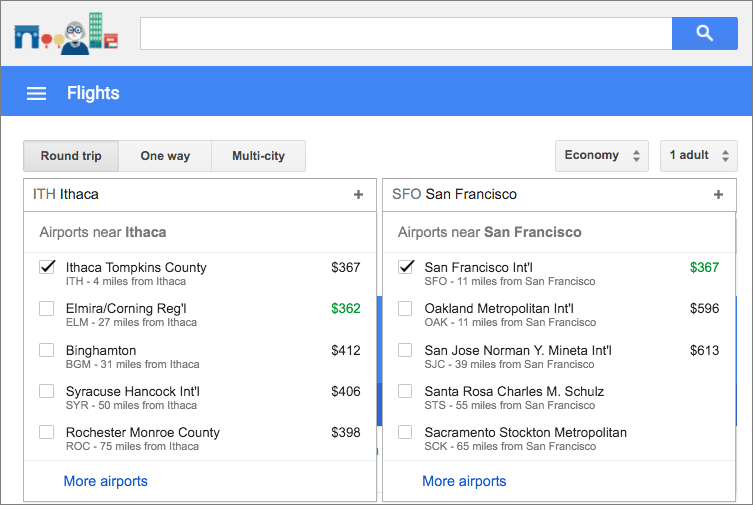
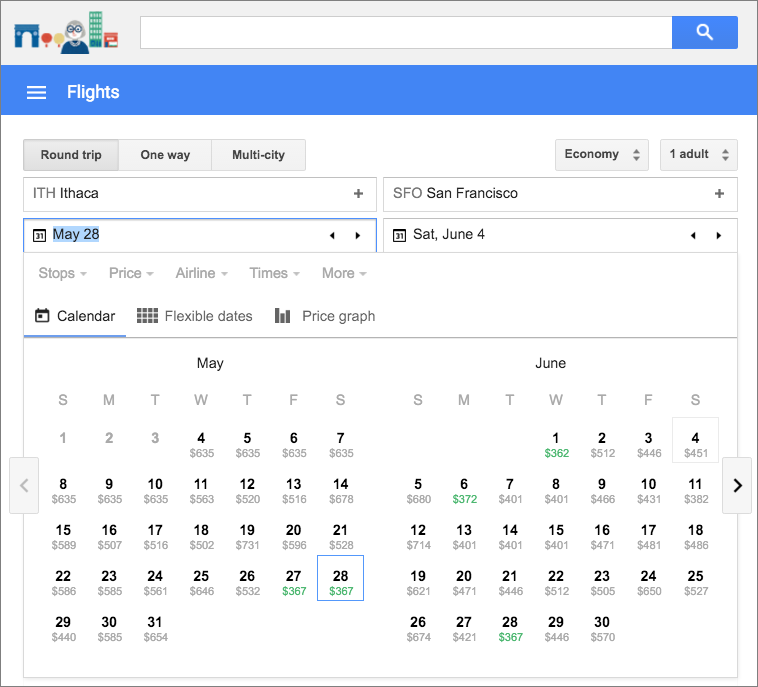

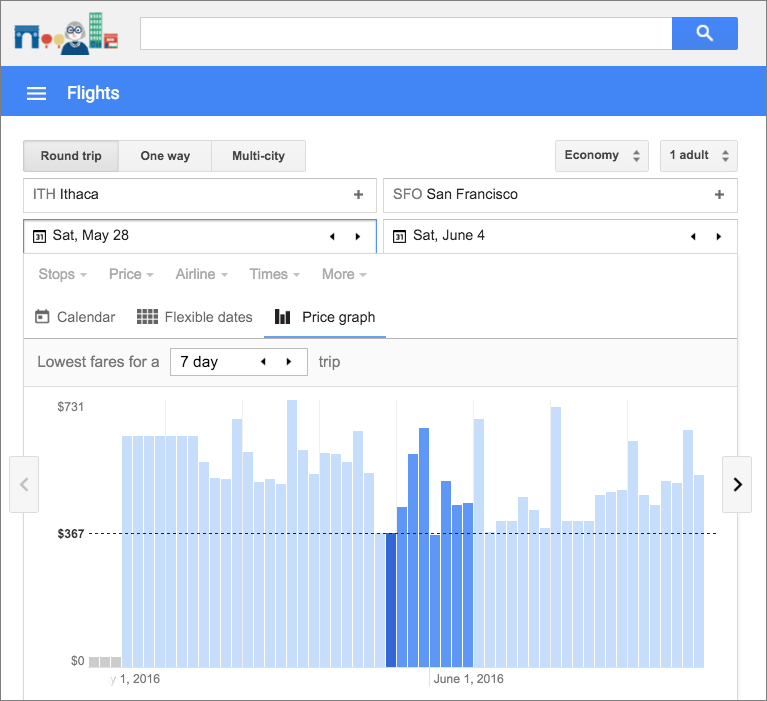
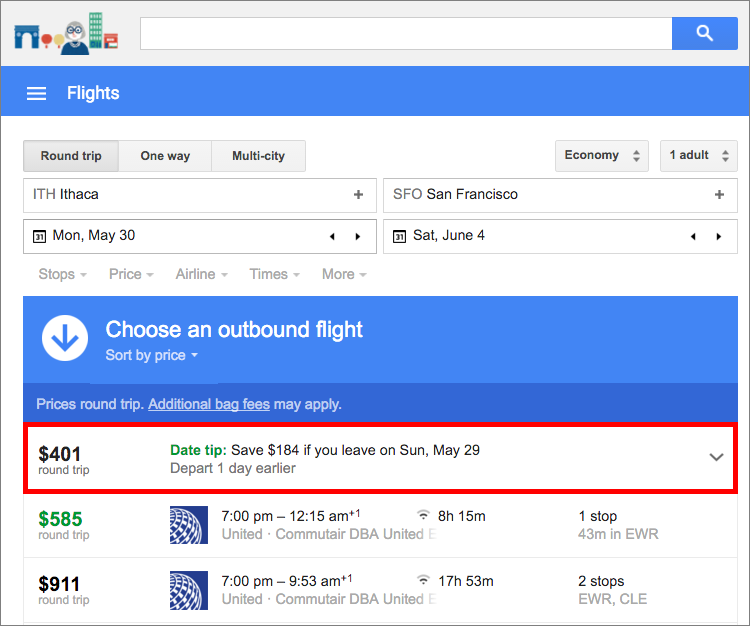
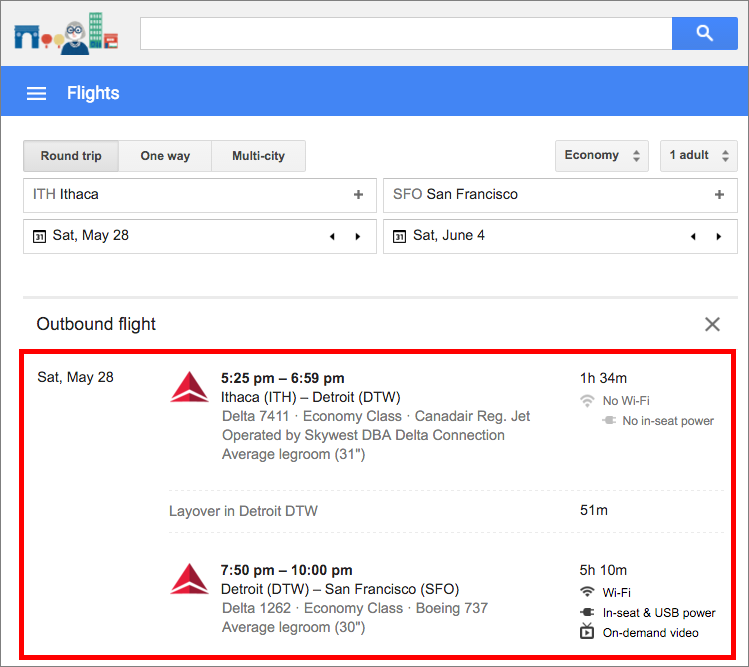

I'm a travel agent and decided to give Google Flights a test. I had an existing business class reservation from Washington DC to Dubai (stop), then to Singapore, returning from Singapore to DC. I could find the flights on Google that I had booked, although they were not the first offered, and Google offered four companies to provide the ticket: Orbitz, Expedia, CheapOair and Emirates, the actual airline used. Only Orbitz offered the correct fare, the other two services were much higher and used connecting flights, and the link to Emirates just took me to its website. In sum, Google was pretty smart finding flights, but the handoff to ticket providers is problematic....
Southwest Airlines is not in the standard databases are used, so quickly checked to see how Google Flights handles it by looking up a Bay Area to Los Angeles round trip.
The good news is that if there is a Southwest routing for the trip, the flights appear with a 'Check Price' notation. There is no direct link to the Southwest site until you actually choose and start to actually book the flights. However, its appearance in the list reminds you to run a parallel process on the Southwest site if there are any such flights.
I wonder why Southwest is not included. Bummer.
There is one very significant problem with Google Flights that renders it useless if you are travelling anywhere outside the US.
This is that it takes the prices directly off the various sites but does not adjust the currency used. So for example, a domestic flight in Australia quoted a number of prices from the two airlines involved, plus orbitz and cheapoair. The price for the latter two was about 10% cheaper than the price offered by the airlines. ….until you went to their site and found the prices were actually quoted in $US and Google had not done the conversion. This meant the cost was actually nearly 30% higher than the prices quoted for the airline itself.
Google Flights also does not include many of the variables in flight costs, even in the US.
• Some airlines include seat choice for free. The non-airline sites charged for seat allocation.
• Some airlines include luggage in the cost. Google does not take account of this.
• Booking with overseas booking operators incurs fees for an overseas credit card transaction. Google cannot include this as it is charged directly to the card owner, but it is a component of the final price.
Google Flights might be ok for finding flight options, but it seems useless for getting a true indication of relative costs.
Good feedback - it sounds like the quality of the data Google gets may vary with country.
Not all credit card companies charge fees for overseas credit card transactions. Capital One and Bank of America Travel are two that don't.
Thank you for that info. I'll make sure I use my Capital One card for any future non-US purchases.
I too like the interface and have started using it extensively to gauge when exactly to fly or with which airline.
But yesterday I really lost confidence. A flight I had found (based to large extent on its low price) ended up according to google costing a certain amount if booked through "online travel agents". There was no link to the airline website (a European flag carrier) but instead a phone number and a remark about a $30 booking fee that would be added if booked over the phone. So I went to the airline's website and indeed found the same flight but low and behold $100 (about 15%) higher than the google price. I checked Expedia too only to find the exact same price that the airline quoted. So I have no idea where google got its fantasy fares from, but if I can't trust their cost estimates, how could I use their tool to compare flights by fares?
Shame. I liked the clean and simple UI.
I'm not sure I'd take this as a reason not to use Google Flights, but merely as yet another example that data must always be taken with a grain of salt until confirmed. Google can only display the data it gets from the airlines and other suppliers, and if that data is wrong in some way, there's probably no way to know. And in the airline industry in particular, there often are weird outlier deals and flights that make a particular combination much cheaper than the alternatives, so it would be hard to programmatically throw out data that seemed out of line. So the two possibilities are that (a) you could see a rate that was lower than reality, as you did, and you'd be disappointed, and (b) that you'd get a notably better deal than you would have had you used a different tool with different data.
Regardless, this does seem to point to the fact that Google Flights seems to much less well with international flights than in the U.S., which I'll note in the article.
I wonder you don't mention my favorite flight-booking app, hipmunk.com. Its display of flight durations is very helpful in choosing flights that depart or arrive with certain windows.
Southwest does not appear in Kayak or Hipmunk either (nor Orbitz nor Expedia nor Travelocity).
I'd never heard of hipmunk.com before, but I'll give it a try!
Hipmunk is wonderful...I particularly like that you can re-order flights by Agony Index.
Another service you might want to check out is Skyscanner. I used them for the last few flights I booked and the interface has some of the features you mention in Google Flights. Overall, I found them to be a lot less fiddly than Kayak and they seem to have full support for international fares and budget airlines.
Thank you! You just reimbursed me for many years of Tidbits subscriptions! Needed to go out of town for a family emergency. One seat left on an Alaska flight. $550 on Alaska's website. $270 on Google Flights, which helped me find the flight in the first place.
Woo! That's great to hear!
Thanks again to you, Adam. Frankly, I've been wondering if TidBits is worth it to me, as I have an old Mac...but now it has proven its worth many times over, thanks to you!!
Thanks for Information about Google Flights Offers a Slick Travel Planning Interface . Your Article is impressive and very informative. I am now regular visitor of your website and bookmarked it.